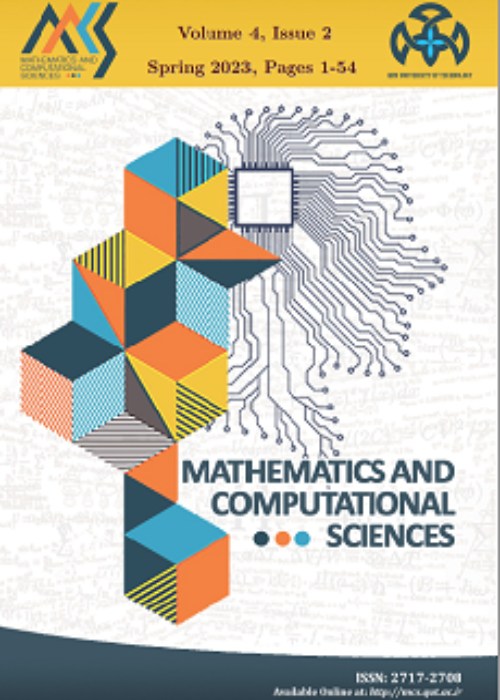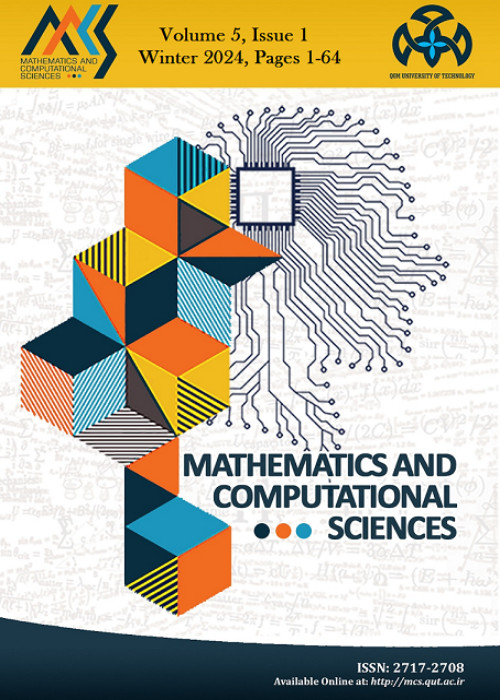فهرست مطالب

Mathematics and Computational Sciences
Volume:4 Issue: 2, Spring 2023
- تاریخ انتشار: 1402/03/11
- تعداد عناوین: 6
-
-
Pages 1-12This paper presents the development and implementation of a numerical method forthe solution of one dimensional Mixed Fredholm Volterra Intergro-Differential Equations(MFVIDEs). The new technique transformed MFVIDEs into an integral equation whichis then approximated using a polynomial collocation method. Standard collocation pointsare then used to convert the problem into a system of algebraic equations. Some numericalexamples are used to test the efficiency and accuracy of the method. The results showthat the new method is efficient, accurate and easy to implement.Keywords: one dimensional Fredholm-Volterra equations, integro-differential equations, polynomial collocation, standard collocation points, Integral equations
-
Pages 13-20In this work, a new type of interpolation formula is introduced. These formulas can be an extension of the Lagrange interpolation formula. The error of this new type of interpolation is calculated. In order to display efficiency of the proposed formulas, three numerical examples are presented.Keywords: Interpolation formula, Error formula, Numerical integration, Trigonometric interpolation
-
Pages 21-24The aim of this paper is to introduce and give preliminary investigation of ∂-partial-locally compact spaces. Locally compactness and ∂-partial-locally compactness are independent of each other. Every locally compact Hausdorff space is ∂-partial-locally compact. But the converse is not true even though it be Hausdorff. ∂-partial-locally compactness is a topological property. ∂-partial-locally compactness is not preserved by the product topology.Keywords: Locally compact, Hausdorff space, ∂-partial-locally compact
-
Pages 25-32Diabetes mellitus is a global health problem, escalating at a disturbing rate due to unbalanced lifestyles and some underlying health issues. In this work, a system of first-order linear ordinary differential equations as well as numerical simulations were employed to gain insight into the dynamics of the disease. The theoretical outcomeof the analysis was derived in terms of the model parameters while computer simulation was used to assess the behavior of the model in terms of the parameter values. Both the theoretical and numerical studies of the model revealed lifestyles and effective treatment as the parameters to be targeted for effective reduction in both diabetes prevalence and mortality. It is therefore concluded that diabetes prevalence and mortality reduction is a function of adjustment in unbalanced lifestyles as well as improvement in diabetes treatment.Keywords: Diabetes Mellitus, lifestyle, Simulation, Mathematical model, Treatments
-
Pages 33-45From an economic point of view, the tourism industry has a special place. Especially in the single-product economy of Iran, it can be used as the best and most optimal alternative to oil. Augmented reality technology is one of the world's newest and most up-to-date applied technologies, highly regarded today. This research focuses on augmented reality and its patterns. This research aims to investigate and develop a practical pattern identification of augmented reality (ar) and its tracking in the tourism industry. Designs are provided by capturing the position and orientation of the device and its location using sensors and Computer vision with screen technology (augmented reality guide). A guide is designed, implemented, and evaluated as an augmented reality application on a mobile phone. The proposed solution has been using deep learning in marker identification. The deep learning architecture used is Yolo, and the proposed method's marker identification results have an accuracy of 68.73 mapsKeywords: Deep Learning, Augmented reality, Tourism Industry, Deep Learning Network
-
Pages 46-54In this article, an attempt has been made to model the process of double integration for different data spacing. The trapezoidal rule has been used to perform integration, whereas Newton's divided difference handles the inconsistent data points. The whole process of numerical integration has been automated in Python programming language. The developed code is tested against two example problems, and the results obtained agree with the one shown in the literature.Keywords: Numerical double integration, Trapezoidal method of integration, Numerical integration, Python programming, Double integration


